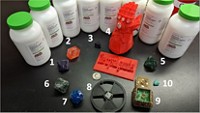Advertisement
Grab your lab coat. Let's get started
Welcome!
Welcome!
Create an account below to get 6 C&EN articles per month, receive newsletters and more - all free.
It seems this is your first time logging in online. Please enter the following information to continue.
As an ACS member you automatically get access to this site. All we need is few more details to create your reading experience.
Not you? Sign in with a different account.
Not you? Sign in with a different account.
ERROR 1
ERROR 1
ERROR 2
ERROR 2
ERROR 2
ERROR 2
ERROR 2
Password and Confirm password must match.
If you have an ACS member number, please enter it here so we can link this account to your membership. (optional)
ERROR 2
ACS values your privacy. By submitting your information, you are gaining access to C&EN and subscribing to our weekly newsletter. We use the information you provide to make your reading experience better, and we will never sell your data to third party members.
Education
Newscripts
A crystal-growing contest and a Nobel Prize-winning inconvenience
by Craig Bettenhausen
December 19, 2016
| A version of this story appeared in
Volume 94, Issue 49
Crystal contest

Crystals fill Jason Benedict’s office once a year. A chemistry professor at the University at Buffalo, Benedict runs the U.S. Crystal Growing Competition (bit.ly/2hwDBvl). This year, 83 entries came in from K–12 students and their teachers.
The contest began three years ago, after Benedict heard of a similar effort in Canada. Starting in mid-October, contestants have about a month to grow the biggest and highest-quality crystals they can and send them to Buffalo.
The raw materials are free to contestants thanks to sponsorships from several companies, nonprofits, and professional societies. This year and last, students used reagent-grade alum. Benedict says alum is a good choice because it is safe, it is one of the easiest crystals to grow, and the resulting crystals are shelf-stable. The sponsorships also allow Benedict to offer cash prizes of $50 to $200 for the winners.
The judges pick winners in two categories: overall, which takes both size and quality into account, and quality, which only requires that the crystal be 0.5 g or larger.


For 2016, the 9–12 grade overall prize winner was the team of Hans Hu and Tenzin Tsetan from the Bronx High School of Science. The 9–12 grade quality prize went to Tim Pan and Neha Verma of the Illinois Mathematics & Science Academy. The K–8 overall prize winner was a student from David Adamson’s class at CREC Montessori in Connecticut. The K–8 quality prize went to Abbey Calhoun and Meghan Leahy of Saint Gilbert School in Illinois.
“My favorite part is seeing the pictures and notes from kids having fun with crystals,” Benedict tells Newscripts. “When you pull a gigantic, golf-ball-sized crystal out of a jar, it’s remarkable. If I’m able to share that with kids ... that’s why I do it.”




Obscured office

As a longtime reporter at C&EN, Stu Borman has earned a prime office on the sixth floor at the American Chemical Society’s headquarters in Washington, D.C. But not long after the Nobel Prize in Chemistry was announced in October, Borman found the view from his office dramatically altered when ACS covered the front of the building with gigantic banners congratulating the 2016 chemistry laureates—Ben L. Feringa, J. Fraser Stoddart, and Jean-Pierre Sauvage.
“No offense, but thanks to you, I can no longer see out of my office window very well,” Borman wrote to Stoddart in a friendly e-mail. “When I look out my window now, all I can see is ‘RAS’ and ‘DDA.’ ”
“Do forgive the intrusion of a part of my name upon your everyday life,” Stoddart replied. “Hopefully, it’s going to be a short-term experience. I guess you can feel yourself lucky that you are not sitting behind my right ear, for I fear I might not have always followed my mother’s advice to wash behind it!”
Craig Bettenhausen wrote this week’s column. Please send comments and suggestions to newscripts@acs.org.





Join the conversation
Contact the reporter
Submit a Letter to the Editor for publication
Engage with us on Twitter